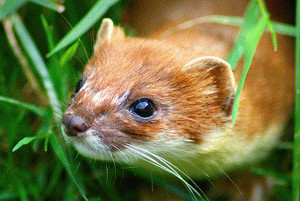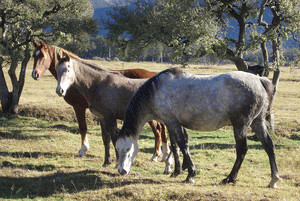 Stoats indirectly impact on the pollination and dispersal of native plants by predating native birds. Photo: Keven Law.Introduced animals encompass any organism that has been introduced by humans either accidentally (such as rats and wasps) or deliberately (such as sheep and cows). Most pest species have both direct and indirect impacts on New Zealand native flora, and unravelling these can be complex. The most well known example of this is the Australian brush-tailed possum which is a serious pest in New Zealand. Direct impacts of these animals include their intense, selective browsing of favoured food plant species (e.g., tree fuchsia, scarlet mistletoe and northern rata) often resulting in extensive canopy defoliation and mortality. However, it is now known that possums also eat eggs, nestlings, and even adult birds of species that are crucial pollinators and seed dispersers, thus impacting on an even wider range of plants and animals than previously believed. Nevertheless, possums may even have a minor beneficial role, e.g., their pollination and dispersal of kiekie (Freycinetia banksii) fruits, a role more usually associated with bats. These same patterns are common to many of our introduced animal pests, yet unravelling these complex interactions and predicting their ultimate impact on our indigenous biota is still in its infancy. Go to the Animal Pest Control section of this website for more information.
Stoats indirectly impact on the pollination and dispersal of native plants by predating native birds. Photo: Keven Law.Introduced animals encompass any organism that has been introduced by humans either accidentally (such as rats and wasps) or deliberately (such as sheep and cows). Most pest species have both direct and indirect impacts on New Zealand native flora, and unravelling these can be complex. The most well known example of this is the Australian brush-tailed possum which is a serious pest in New Zealand. Direct impacts of these animals include their intense, selective browsing of favoured food plant species (e.g., tree fuchsia, scarlet mistletoe and northern rata) often resulting in extensive canopy defoliation and mortality. However, it is now known that possums also eat eggs, nestlings, and even adult birds of species that are crucial pollinators and seed dispersers, thus impacting on an even wider range of plants and animals than previously believed. Nevertheless, possums may even have a minor beneficial role, e.g., their pollination and dispersal of kiekie (Freycinetia banksii) fruits, a role more usually associated with bats. These same patterns are common to many of our introduced animal pests, yet unravelling these complex interactions and predicting their ultimate impact on our indigenous biota is still in its infancy. Go to the Animal Pest Control section of this website for more information.
 Feral horses can modify plant communities by grazing and trampling. Photo: Jesse BythellFor more detailed information about animal pests follow the links below:
Feral horses can modify plant communities by grazing and trampling. Photo: Jesse BythellFor more detailed information about animal pests follow the links below:
For more information about New Zealand’s animal pests see the following:
